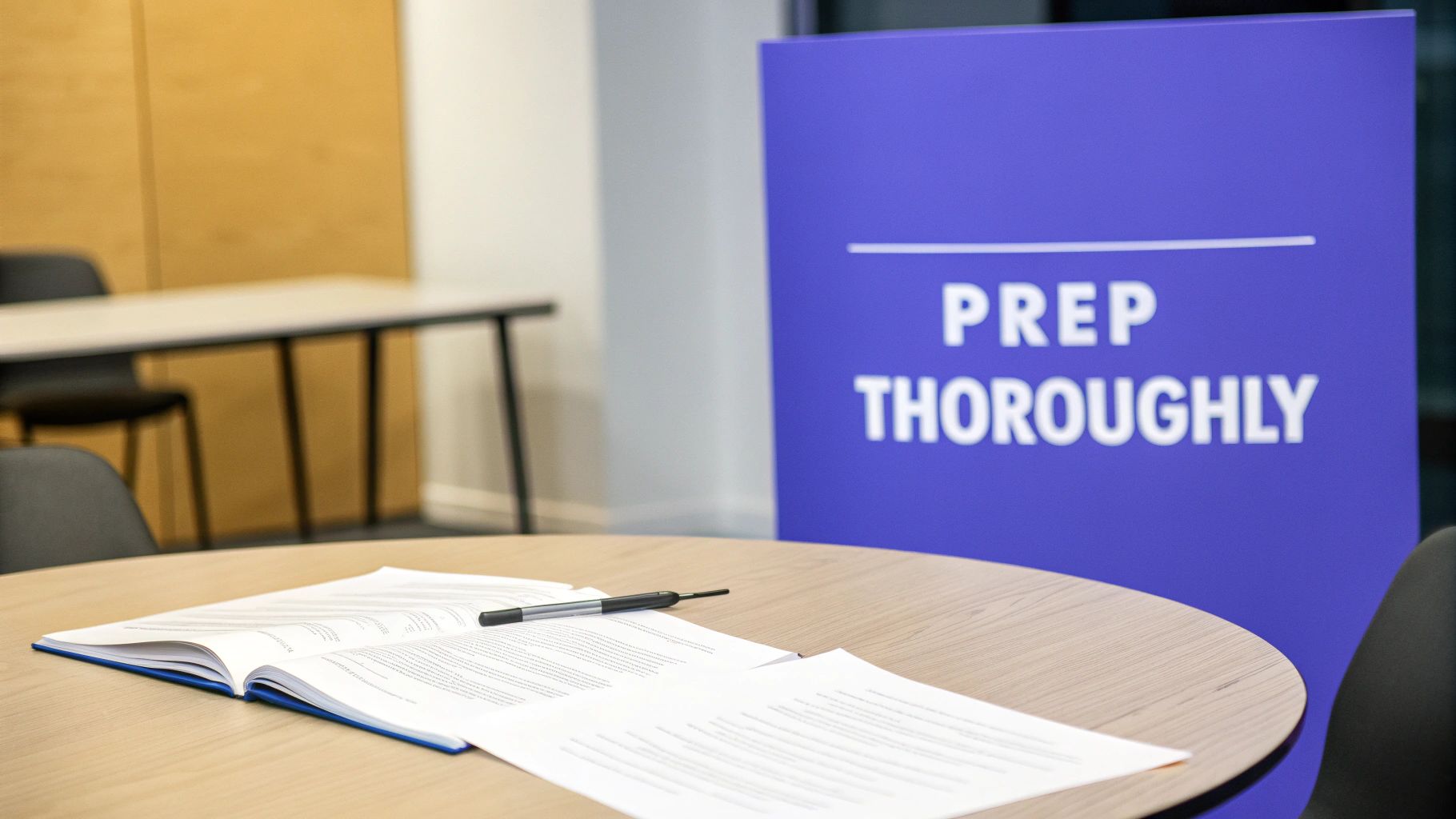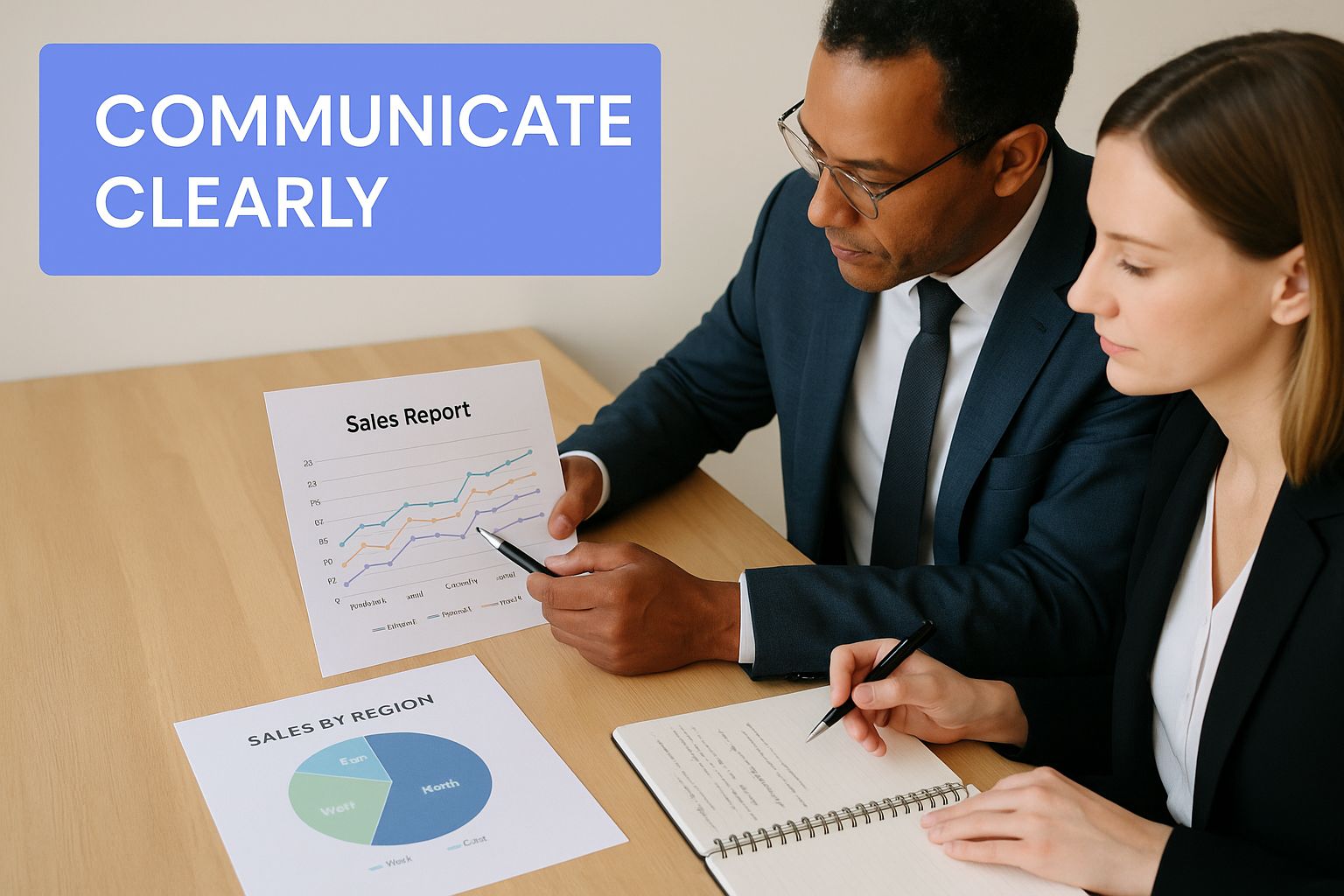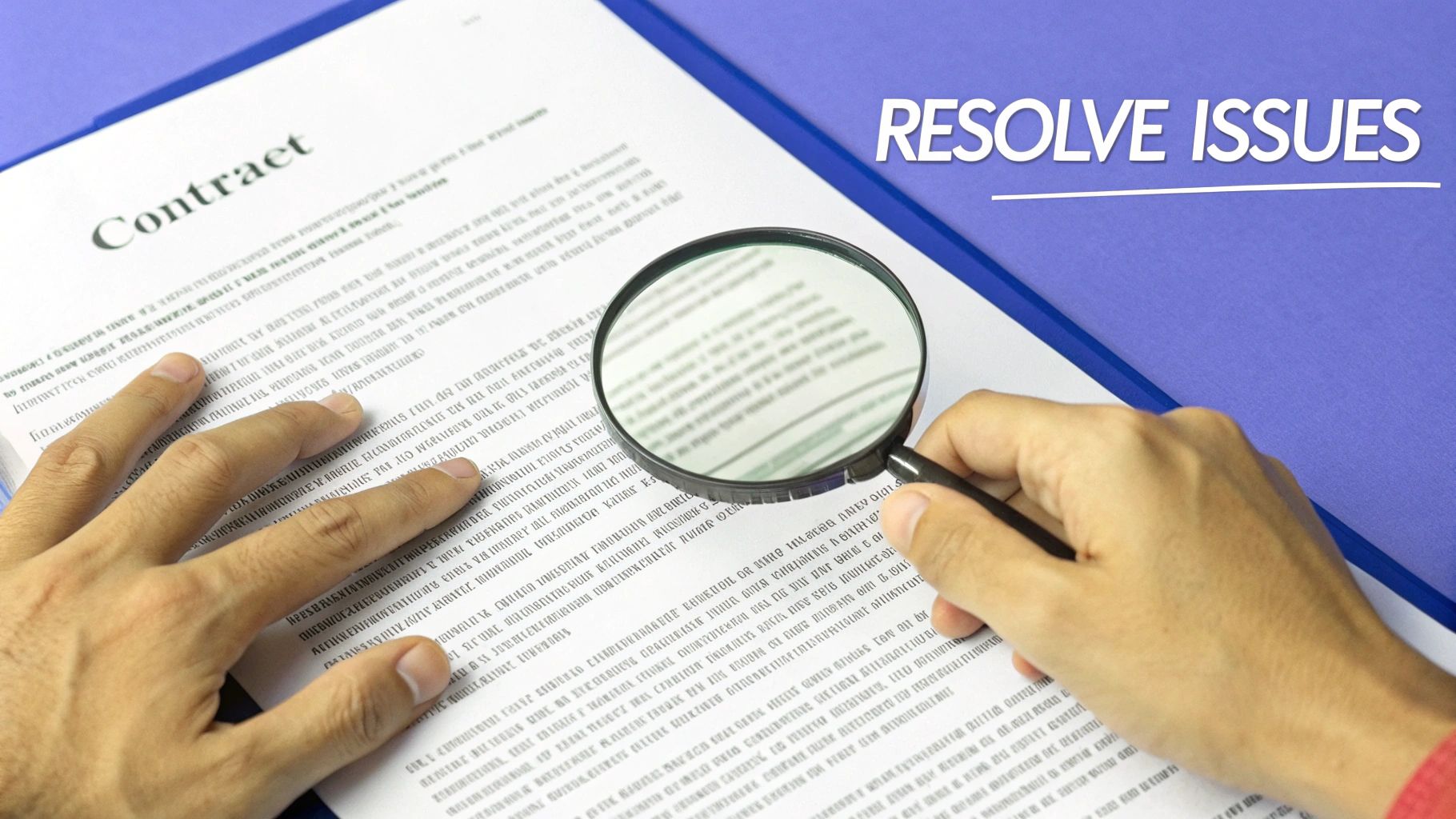
Negotiating a contract isn't some dark art—it's a core business skill built on a pretty straightforward foundation: solid preparation, smart communication, and a genuine focus on creating mutual value. Real success hinges on understanding the other party's goals just as deeply as your own. When you do that, a process that could feel adversarial suddenly becomes a collaborative effort.
Your Framework for Successful Negotiation
Learning how to negotiate contracts effectively isn't about memorizing abstract theories or aggressive tactics. It’s about having a practical, repeatable process. The whole thing, from the initial research to the final signature, follows a clear roadmap. Think of it like building a legal case; the more evidence and understanding you gather upfront, the stronger your position becomes.
A successful negotiation is almost always won before anyone even sits at the table. It starts with a deep dive into not just what you want, but what you absolutely need. That distinction is critical. Your "wants" are your nice-to-haves, the flexible points. Your "needs," on the other hand, define your walk-away points.
The Three Pillars of Negotiation
To help organize your approach, it's useful to think about negotiation strategy as resting on three core pillars. These pillars guide your actions and decisions from start to finish.
| Pillar | Core Principle | Key Action |
|---|---|---|
| Preparation | Knowledge is power. | Research market rates, understand the other party's pain points, and define your Best Alternative to a Negotiated Agreement (BATNA). |
| Communication | How you say it matters. | Listen actively, ask clarifying questions, and present your terms with confidence and clear reasoning. |
| Collaboration | Find the win-win. | Shift from a zero-sum game to a problem-solving mindset to build a stronger, more valuable long-term partnership. |
These pillars aren't just concepts; they are the bedrock of a solid negotiating position. Mastering them turns you from a passive participant into the one driving the conversation toward a favorable outcome.
Modern tools can give you a serious edge, especially in the prep phase. For instance, running an initial draft through a tool like Legal Document Simplifier can instantly clarify dense legalese. It helps you spot confusing language or unfavorable clauses before discussions even begin, so you can walk into the room armed with data-backed confidence.
A common mistake is treating the signed contract as the finish line. It's not. The signed document is just the starting pistol for the relationship. Making sure both sides feel the agreement is fair is absolutely crucial for smooth execution and effective contract compliance management.
Preparing to Win Before You Negotiate

The best negotiators know that a winning outcome is often decided long before anyone sits down at the table. This prep phase is what separates the pros from the amateurs. It’s not just about knowing what you want—it’s about understanding the entire deal from every angle.
Solid preparation starts with doing your homework on the other party. What pressures are they facing? Who are their biggest competitors? A quick scan of their recent press releases, social media, or industry news can tell you if they’re coming from a position of strength or weakness. This context is gold when you're figuring out how to negotiate contracts.
Define Your Walk-Away Point
Before you even think about starting a conversation, you absolutely must know your BATNA—your Best Alternative to a Negotiated Agreement. This isn't just a vague "plan B." It's a real, specific action you'll take if the negotiation falls apart.
So, what does that look like? If you're a freelance designer negotiating a new project, your BATNA might be another, smaller project you've already been offered. Knowing you have that solid alternative gives you the confidence to walk away from a bad deal.
Once your BATNA is clear, you can set your walk-away point. This is the absolute bottom line, the least favorable deal you're willing to accept. It should always be just slightly better than your BATNA.
Your BATNA is your power source. It’s the safety net that gives you the confidence to say "no." Without a clear BATNA, you're not negotiating from strength; you're negotiating from desperation.
Build Your Negotiation Toolkit
With your bottom line set, it’s time to pull together all the information you need to back up your position. A well-organized toolkit keeps you from getting caught off guard and lets you answer questions with data-driven confidence. Don't rely on your memory for this stuff.
Your toolkit should include:
- Market Research: Collect data on industry-standard rates, terms, and conditions for similar deals. This is your reality check for justifying your offers and pushing back on unrealistic ones.
- Key Documents: Have all relevant files handy, like past contracts, important emails, or project proposals.
- A List of Questions: Prepare smart questions for the other side. Good questions can uncover their real interests and what they truly value.
- Your Ideal Outcome: Clearly map out what a perfect deal looks like for you, covering every key term and condition.
Here's a powerful move: run the draft contract through a tool like Legal Document Simplifier before you start talking. You can get a plain-language summary that flags confusing clauses or hidden risks. This lets you walk into the room already knowing which parts of the contract demand the most attention.
For instance, you might find a one-sided indemnification clause you absolutely need to address. This kind of foresight changes your entire approach. You shift from just reacting to the document to strategically shaping it from the start. This proactive analysis is a cornerstone of how to negotiate contracts effectively.
Negotiating Terms Amidst Market Volatility
You’ve probably noticed that contracts are almost never negotiated in a vacuum. The ground can shift right under your feet—thanks to market swings, supply chain meltdowns, and global events that can completely torpedo the assumptions a deal was built on. Learning to negotiate effectively means you have to plan for this instability, not pretend it won’t happen.
When outside factors are unpredictable, your leverage can change overnight. A sudden jump in raw material costs or a new tariff can weaken one party's position while beefing up another's. The real secret is to see this coming and build some wiggle room directly into the agreement from the very beginning.
Building Resilience into Your Agreements
The best way to shield your interests from future shocks is to negotiate specific clauses that account for change. Instead of getting locked into rigid terms that could bite you later, you can propose conditions that adapt to new realities.
Think about weaving in these strategic clauses:
- Price Adjustment Clauses: These let you reopen price talks if certain market indicators, like a specific commodity price, shift by a set percentage.
- Force Majeure Clauses: Don’t just settle for the boilerplate here. Get specific about what counts. Instead of vague "acts of God," name the events that would trigger the clause, like "port closures in specific regions."
- Flexible Volume Commitments: Rather than being stuck with fixed quantities, push for a range—say, 80% to 120% of the forecasted amount. This gives you breathing room to handle swings in supply or demand.
This image really drives home a core principle for bringing up these more complex terms.

When you're introducing these kinds of adaptive clauses, crystal-clear communication is vital. You need to make sure both sides fully understand the triggers and the consequences to sidestep any ugly disputes down the road.
Using Data to Anchor Your Position
In a shaky market, data isn't just helpful—it's your most powerful ally. Gut feelings about where the market is headed are flimsy, but hard numbers are tough to argue with. Bring current, relevant data to the table to justify your proposals and push back against the other side's claims.
The global freight industry is a perfect example. Ongoing geopolitical turmoil has made long-term contract pricing a huge headache. Data shows that even with hopes of routes normalizing, spot rates from the Far East to the US East Coast stayed inflated by an average of 142%. And for new contracts starting in early 2025, rates went up in 7 of the 9 major global trades compared to the year before. You can dive deeper into how these events are shaking up freight negotiations in recent Xeneta analyses.
Using this kind of specific, third-party data takes the emotion out of the discussion. It changes the conversation from "I think prices will..." to "The market data shows..., so let's build an agreement that reflects this reality."
This approach flips your position from defensive to strategic. You’re not just reacting to risk; you’re getting out ahead of it. A thorough contract risk assessment is a non-negotiable step in this process, as it helps you pinpoint which terms are most exposed to market volatility. By flagging these high-risk areas before talks even start, you can focus your data-gathering efforts and craft clauses that give you a necessary buffer, protecting your interests no matter which way the market turns.
Building Rapport and Trust to Close Deals

It’s easy to get lost in data and clauses, but at the end of the day, negotiation is about people. The best agreements don’t come from aggressive tactics; they’re built on a foundation of genuine respect and understanding. When you make an effort to build real rapport, the whole dynamic changes from a battle to a joint problem-solving session.
This isn't about being soft—it's about being smart. Taking the time to understand the person on the other side of the table—what drives them, the pressures they’re under, how they communicate—gives you a massive advantage. It's this human connection that often breaks a stalemate and turns a decent deal into a fantastic one.
The Power of Active Listening
Most people in a negotiation are too busy thinking about their next point to really hear what the other party is saying. Active listening is your most underrated tool. It’s not just hearing words; it’s about catching the intent, the emotion, and the context behind them.
So, when someone brings up an objection, don't jump straight to a rebuttal. Instead, dig a little deeper. Try asking simple questions like, "Can you help me understand your concern with that point?" or "What would an ideal outcome look like for you here?" These questions can uncover their true interests. More often than not, their stated position isn't what they actually need.
A core part of learning how to negotiate contracts is realizing you're searching for the "why" behind their "what." The "what" is their demand; the "why" is the problem they're trying to solve. If you can address the "why," the "what" suddenly becomes a lot more flexible.
Interpreting More Than Words
So much of communication happens without a single word being spoken. You have to pay close attention to non-verbal cues. Does their body language line up with what they're saying? Someone might verbally agree to a term but show their hesitation by leaning back and crossing their arms.
- Posture and Gestures: An open, relaxed posture usually means cooperation is in the air. Tense or closed-off body language can signal resistance.
- Tone of Voice: Is the tone collaborative or confrontational? A sudden shift can point to a particularly sensitive issue.
- Eye Contact: Consistent eye contact often signals confidence and sincerity, while avoiding it might indicate discomfort or a lack of certainty.
These cues are like a secondary channel of information. They help you read the emotional temperature of the room and adjust your strategy in real-time.
Using Concessions to Build Goodwill
A lot of negotiators see concessions as a sign of weakness. But when you use them strategically, they become a powerful way to build trust and keep the conversation moving forward. The trick is to never just give something away.
Frame every concession as a direct response to a need they've expressed. This shows you’re listening and actively trying to find a middle ground. For instance, if they're pushing hard for a lower price, you could agree—but in exchange for a longer contract term or faster payments. This "if you, then I" approach makes every concession a trade, not a surrender, and builds a sense of fairness.
This move away from rigid, zero-sum games is a growing trend. Businesses are figuring out that transparency and genuine rapport are far more effective. Inflexible strategies can seriously damage a brand's reputation and alienate valuable partners. In fact, many modern negotiators bake strategic concessions into their opening offers, knowing that a little flexibility can lead to much better deals. You can explore these evolving negotiation trends and statistics to see how relationship-focused approaches are becoming the new standard.
By focusing on trust, you're not just closing one deal—you're opening the door to a strong, productive partnership that can last for years.
Turning Your Agreement into an Ironclad Contract
A handshake and a verbal agreement feel great. It’s the moment you know you’ve got a deal. But that’s just the starting line. The real work is turning those spoken promises into a clear, legally sound document. This is where a great partnership is either cemented in place or starts to unravel from ambiguity.
Translating your discussion into a formal contract is one of the most critical steps you’ll take. Every single detail—from the scope of work and payment milestones to liability caps and termination rights—needs to be captured in language that leaves no room for interpretation. A term that seemed perfectly fine in conversation can quickly become a major headache down the road if it’s not nailed down.
Drafting with Precision and Clarity
When you start writing the contract, think of precision as your best defense against future arguments. Never assume something is "standard" or "obvious." Spell out every detail, no matter how minor it seems at the time.
Imagine hiring a freelance software developer. Agreeing to "build a new mobile app" is a recipe for disaster. A truly solid contract would get much more specific:
- Deliverables: What exact features are included in version 1.0?
- Timeline: What are the deadlines for wireframes, the beta version, and the final launch?
- Payment Terms: How much is due after each specific milestone is hit?
- Revisions: How many rounds of changes are included, and what's the cost for anything extra?
This level of detail transforms a loose idea into an actionable plan. There’s simply no space left for misunderstanding.
The goal isn't to create a document packed with intimidating legal jargon. It's to create something so clear that both sides know exactly what to do and what to expect. A truly strong contract prevents arguments because the answers are already written down.
The Vital Review and Finalization Process
Once the draft is written, it's time for review. And this isn't the time to skim. Every word matters. This is your last real chance to catch confusing language or potential loopholes before you sign. A thorough review is absolutely non-negotiable.
This isn’t a new problem. Even back in the late 1970s, complex sectors like technology and telecommunications were using highly structured methods for drafting and reviewing contracts for hardware and software. These early frameworks for defining terms and assessing costs laid the groundwork for today's meticulous contract practices, where every clause is scrutinized to manage risk. You can see some of these foundational strategies in a 1980 Datapro report on communication solutions.
This is where modern tools can give you a massive edge. A Legal Document Simplifier can instantly translate dense legalese into plain English, flagging ambiguous terms or one-sided clauses you might have missed. If you want to get better at spotting these issues yourself, our guide on how to read contracts is a great place to start. This pre-analysis helps you pinpoint problems and suggest clearer language before it’s too late.
After all the revisions are made and both parties give the final thumbs-up, it’s time to sign. Getting those signatures—whether on paper or electronically—makes the agreement official and turns it into a legally binding commitment. This final step locks in all your hard work, converting your successful negotiation into a protected, actionable business relationship.
Of course. Here is the rewritten section, designed to sound like an experienced human expert and match the provided examples.
Answering Common Contract Negotiation Questions
Even with the best game plan, a negotiation can feel like walking a tightrope. Every deal has its own quirks, but after a while, you start to see the same tricky situations pop up again and again. Let's get into some of those recurring questions and how to handle them.
Who Should Make the First Offer?
This is the classic question, and there's a lot of debate around it. Traditional wisdom often tells you to wait for the other side to show their hand. But a more modern take is that making the first offer can be an incredibly powerful move—if you’ve done your homework.
When you go first, you get to anchor the negotiation. You set the starting point for the whole conversation, framing the value around your terms. This strategy works best when you have hard data on market rates and a crystal-clear understanding of the value you're bringing to the table.
But what if you're not so sure? If you're walking in a bit blind about the other party's budget or what the market standard is, it’s much smarter to let them go first. Their opening number gives you a ton of valuable intelligence about their expectations before you have to commit to anything.
What’s the Single Biggest Mistake People Make?
Hands down, the most common and costly mistake is poor preparation. So many people walk into a negotiation with a vague sense of what they want, but they haven't thought through the critical details. They don't know their BATNA (Best Alternative to a Negotiated Agreement), their absolute walk-away point, or what the other party really needs from the deal.
Without this strategic foundation, you're essentially negotiating from a position of weakness. You're far more likely to accept a bad deal or give up things you’ll regret later. Solid research and planning aren't just a nice-to-have; they're the bedrock of a successful outcome.
How Do You Negotiate When the Other Side Has All the Power?
It's a tough spot to be in. What do you do when the other side seems to hold all the cards? When you're facing a power imbalance, you have to shift your focus from leverage to interests.
Even the most powerful company or person has needs they want this deal to satisfy. Your job is to figure out what those underlying interests are and position your proposal as the best way to meet them. Get creative and find ways to add value in areas they might not have even considered.
Most importantly, you need to strengthen your BATNA. Having a strong, viable alternative to their deal gives you the genuine confidence to walk away. That's your ultimate source of power. It completely changes the dynamic—it's no longer about you needing them, but about them needing to offer you something better than your next best option.
Feeling overwhelmed by dense legal documents during your negotiations? Legal Document Simplifier can instantly translate complex contracts into clear summaries, highlighting key terms, risks, and obligations. Empower yourself with the clarity needed to negotiate effectively and confidently. Try it now at https://legaldocumentsimplifier.com.